Sharks are known for their large, stocky bodies with cartilaginous skeletons, prominent dorsal fins, and rows of sharp teeth. Sharks are one-of-a-kind fish; however, many different species of fish resemble these intimidating sharks. Although they may not have all of the features that sharks have, the similarities they do have may surprise you. Keep reading to find the 16 amazing fish that look like sharks.
Bowmouth Guitarfish (Rhina ancylostoma)

With its large dorsal and tail fins, the bowmouth guitarfish looks similar to a shark.
©chonlasub woravichan/Shutterstock.com
Bowmouth guitarfish is a species of ray that lives in the tropical coastal waters of the western Indo-Pacific. This fish is highly distinctive, with a wide and thick body and a rounded snout. The fish also has a large dorsal fin and tail fins. The bowmouth guitarfish also has multiple thorny ridges over the head and back. Lastly, this fish has a bowed mouth where it gets its name. It is bluish-gray to brown in color and has many white spots on the dorsal aspect. The bowmouth guitarfish is a large fish and can reach a length of 9 feet and weigh around 300 pounds.
The bowmouth guitarfish is generally found near the sea floor. These fish are predators and hunt fish, crustaceans, and mollusks. They locate their prey primarily through smell, as their eyes are located on the top of their head.
The bowmouth guitarfish shares some similarities with sharks, mostly due to its dorsal and tail fins. Because of these fins, the bowmouth guitarfish resembles a shark from far away. However, once you see the wide and thick body, it is quite apparent that it is not a shark.
Sawfish (Pristidae)

A critically endangered species, the sawfish has a rough body texture similar to that of a shark.
©Kolf/Shutterstock.com
Sawfish, also known as carpenter sharks, are a critically endangered species that can be found in warm coastal areas worldwide. They get their name from their long snout, which has rows of spines on either side, resembling a saw. This “saw” has small pores that can sense electric fields in the water from passing prey. There are four different subspecies of sawfish, including largetooth, green, smalltooth, and knifetooth sawfish. These fish can range in color from green and brown to grey. They can grow anywhere between 10 to 23 feet long and weigh from 220 to over 1000 pounds!
The diet of the sawfish is mainly other fish. However, they are very opportunistic feeders and have been observed eating crustaceans, squid, and other small marine animals. The sawfish waits for prey to pass close by and then uses its snout to stun its prey before eating it.
Sawfish are closely related to sharks and therefore share few similarities. One of these similarities is the fish’s scale which gives its body a rough texture, just like a shark. Another is that they have shark-like dorsal fins.
Mekong Giant Catfish (Pangasianodon gigas)
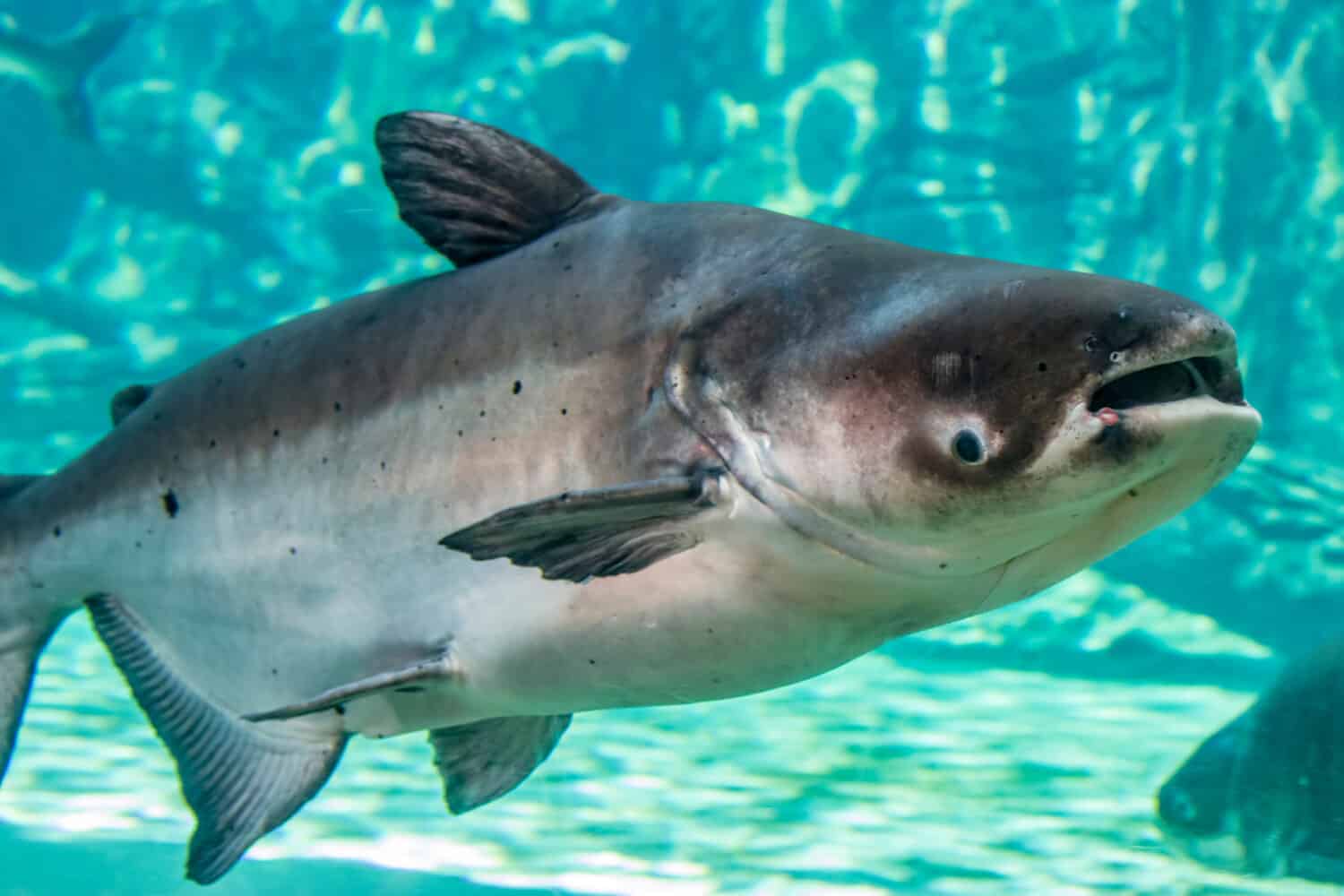
Similar to some sharks, the Mekong giant
catfish
can grow up to 10 feet long.
©Danny Ye/Shutterstock.com
The Mekong giant catfish is a large fish in the shark catfish family that is endemic to the Mekong River. This fish is one of the largest species of freshwater fish. It can grow to a length of 10 feet and can weigh up to 770 pounds. The Mekong giant catfish is grey to white in color and does not have stripes, barbels, or teeth. Its eyes are set low on their heads below the mouthline.
This large fish, as scary as it looks, is quite harmless as they are almost entirely herbivores. They feed mostly on algae and other plant life that grows on the riverbed. Juveniles will feed on zooplankton.
The Mekong giant catfish is similar to sharks in size and physical features. The angular dorsal fin, in particular, and the position of the eyes are really what makes them look like sharks. Unlike sharks, however, these gentle creatures don’t have teeth!
Chinese High-Fin Banded Shark (Myxocyprinus asiaticus)

Although much smaller, the Chinese high-fin banded shark has a high dorsal fin, just like a shark!
©Pavaphon Supanantananont/Shutterstock.com
The Chinese high-fin banded shark is a freshwater fish. This species is a very popular aquarium pet due to its resemblance to sharks. The fish has bands of black and white around its body and a very high dorsal fin from which this fish gets its name. They can grow over 4 feet long and weigh up to 90 pounds.
Chinese high-fin banded sharks often like to graze on algae but are also opportunistic feeders where protein is their preferred meal. They like to eat insects, crustaceans, and mollusks, as well as earthworms and brine shrimp.
These freshwater fish have a similar body shape to sharks. Their bodies are long and elongated, and their high dorsal fin gives them a shark-like appearance as they swim through the water.
Iridescent Shark (Pangasianodon hypophthalmus)
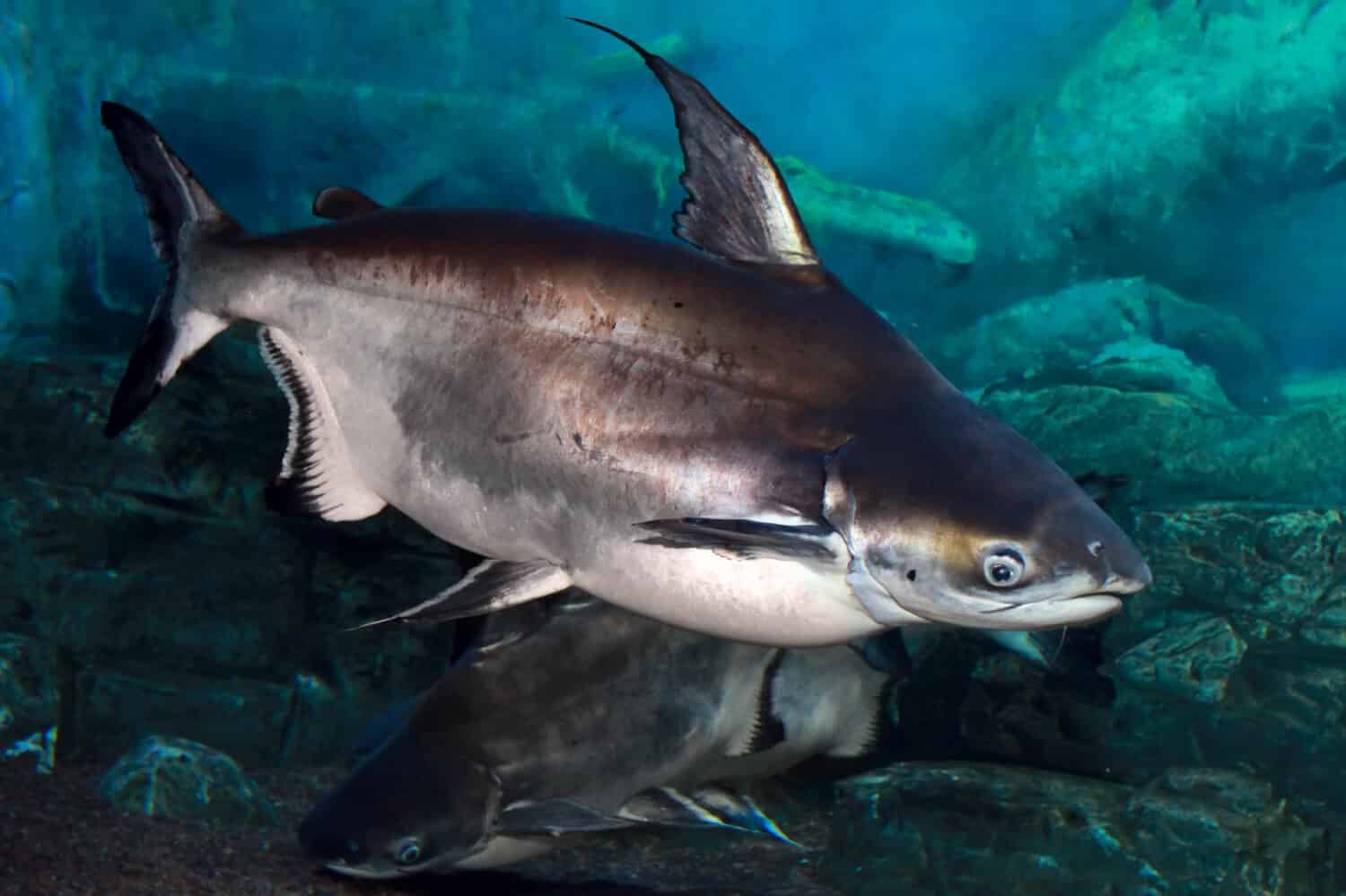
With similar fins and tails to a shark, iridescent sharks can grow up to 4 feet long.
©Tatiana Belova/Shutterstock.com
Iridescent sharks are not sharks but belong to the shark catfish family. These fish are large and can reach a length of 2-4 feet and weigh between 50 and 100 pounds. The iridescent shark has silver scales and beige skin. Their whiskers are small and not prominent, and they have a small dorsal fin like other shark catfish. One distinguishing feature is the glowing edges of their fins, which gives them their name.
Iridescent sharks are omnivores and feed on crustaceans, algae, insects, and small fish. These fish are popular prey to predators including birds, mammals, and other fish.
The iridescent shark has similar fins and tails to a shark.
Black Sharkminnow (Labeo chrysophekadion)
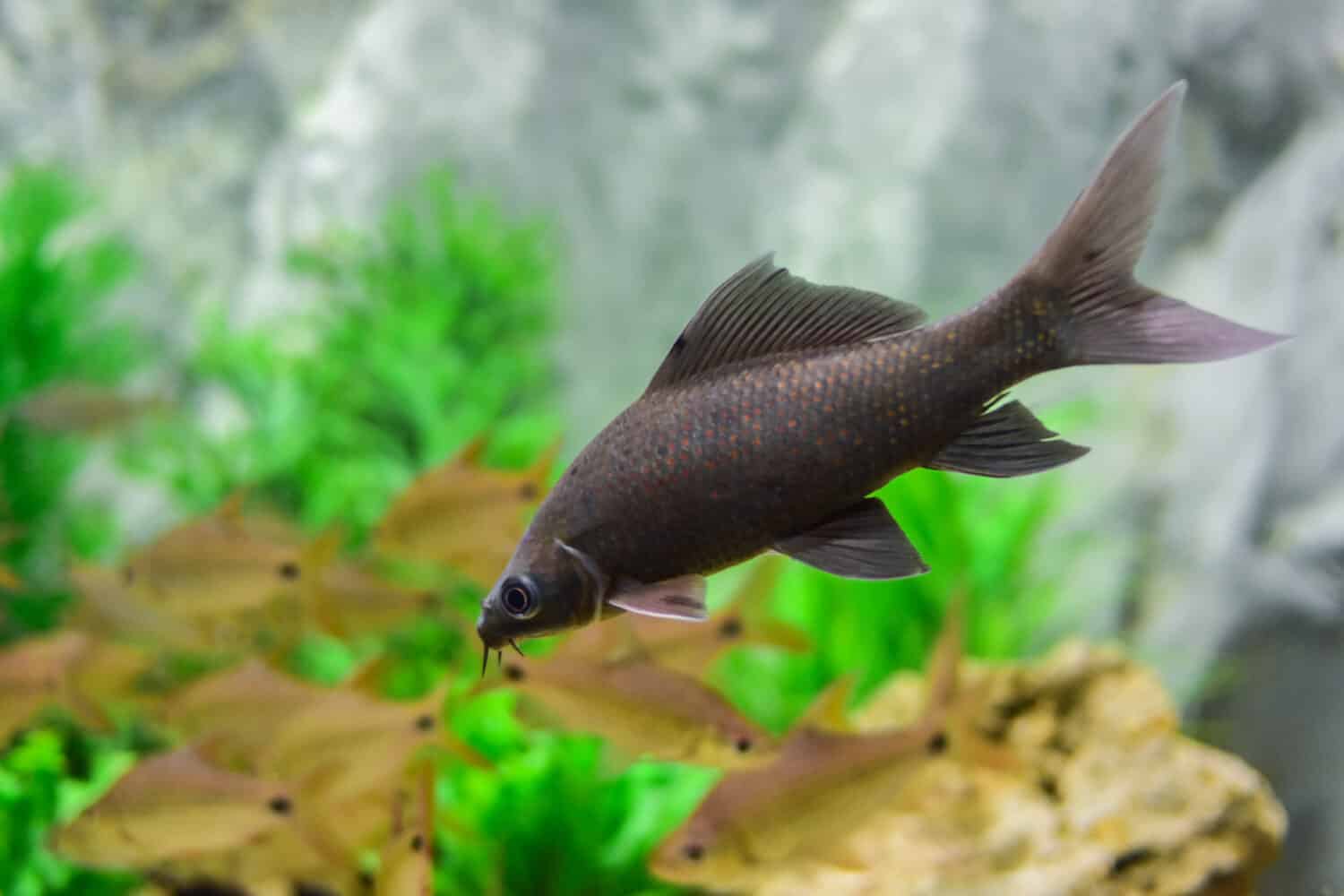
Unlike sharks, the black sharkminnow is a popular aquarium fish.
©Watcharin Tadsana/Shutterstock.com
The black sharkminnow is a freshwater fish in the carp family. This fish is also commonly known as black shark or black labeo. The black sharkminnow is medium-sized and can reach a length of 3 feet and weigh 15 pounds. As the name suggests, this fish is black in color. Additionally, adult black sharkminnows have one iridescent spot on each scale. A distinguishing feature of the black sharkminnow is its large dorsal fin and anterior dorsal rays, which are longer than the length of the head. This species of fish can be kept in aquariums.
The black sharkminnow is a grazer and feeds on algae, crustaceans, insect larvae, and more. These fish are omnivorous and are not picky eaters, eating anything that can fit into their mouths.
Black sharkminnows resemble sharks not only in their name but in their fins. However, the fins of the black sharkminnow are much softer than a shark’s.
Bala Shark (Balantiocheilos melanopterus)
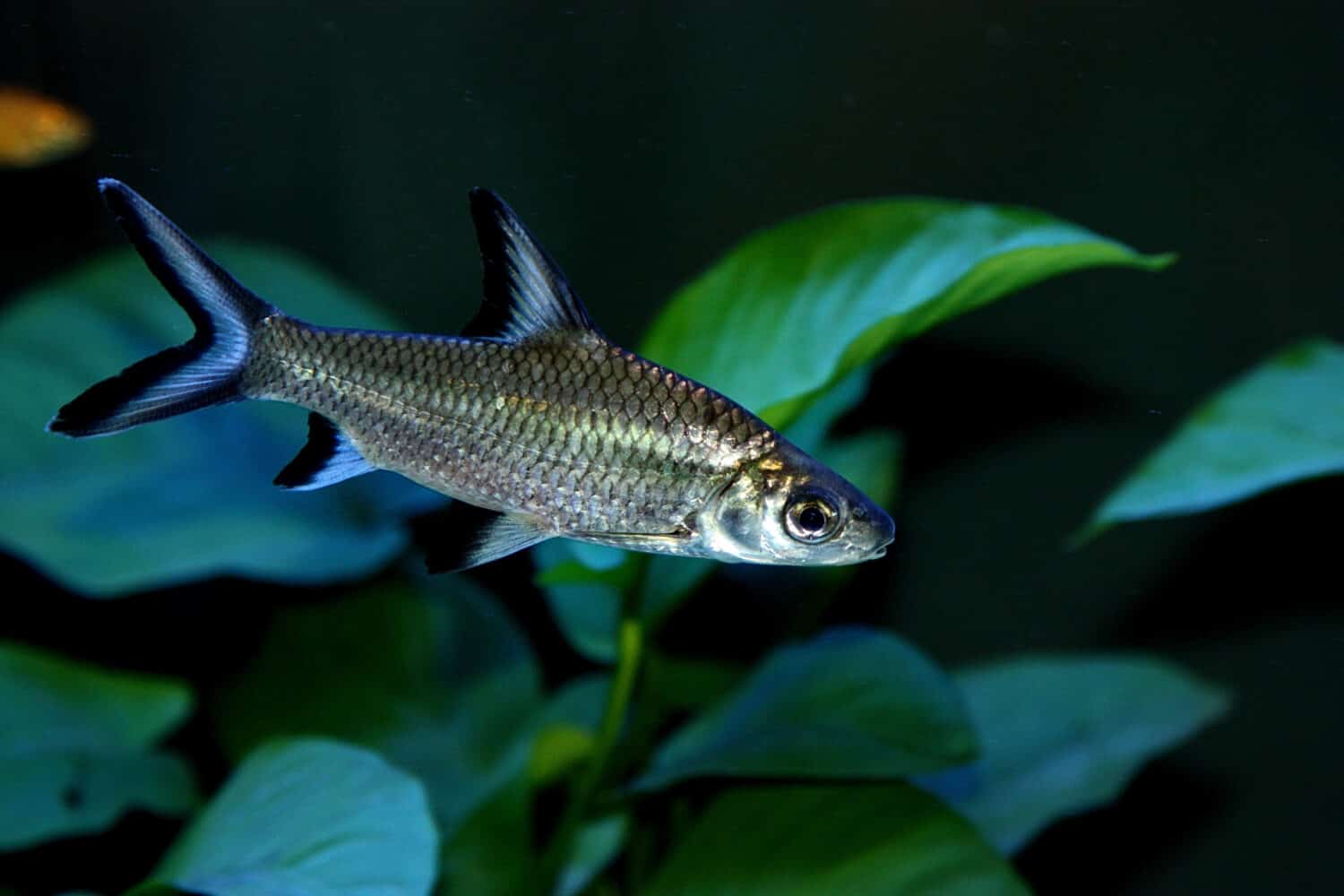
While not a true shark, the bala shark shares some similarities, including its sharp fins and forked tail.
©Arunee Rodloy/Shutterstock.com
Bala sharks are another freshwater shark impersonator and are a member of the carp family. They have “torpedo” shaped bodies and distinctive sharp fins and dorsal. They have silver bodies, black fins, and yellow patches scattered across the body.
The diet of the bala shark consists of phytoplankton, small crustaceans, insects, and insect larvae. Aquarium bala sharks will eat frozen brine shrimp, bloodworms, algae, and flake or pelletized food.
The bodies and fins of the bala shark closely resemble those of sharks. In particular, their sharp fins and forked tail make these fish look like sharks while swimming.
Paroon Shark (Pangasius sanitwongsei)
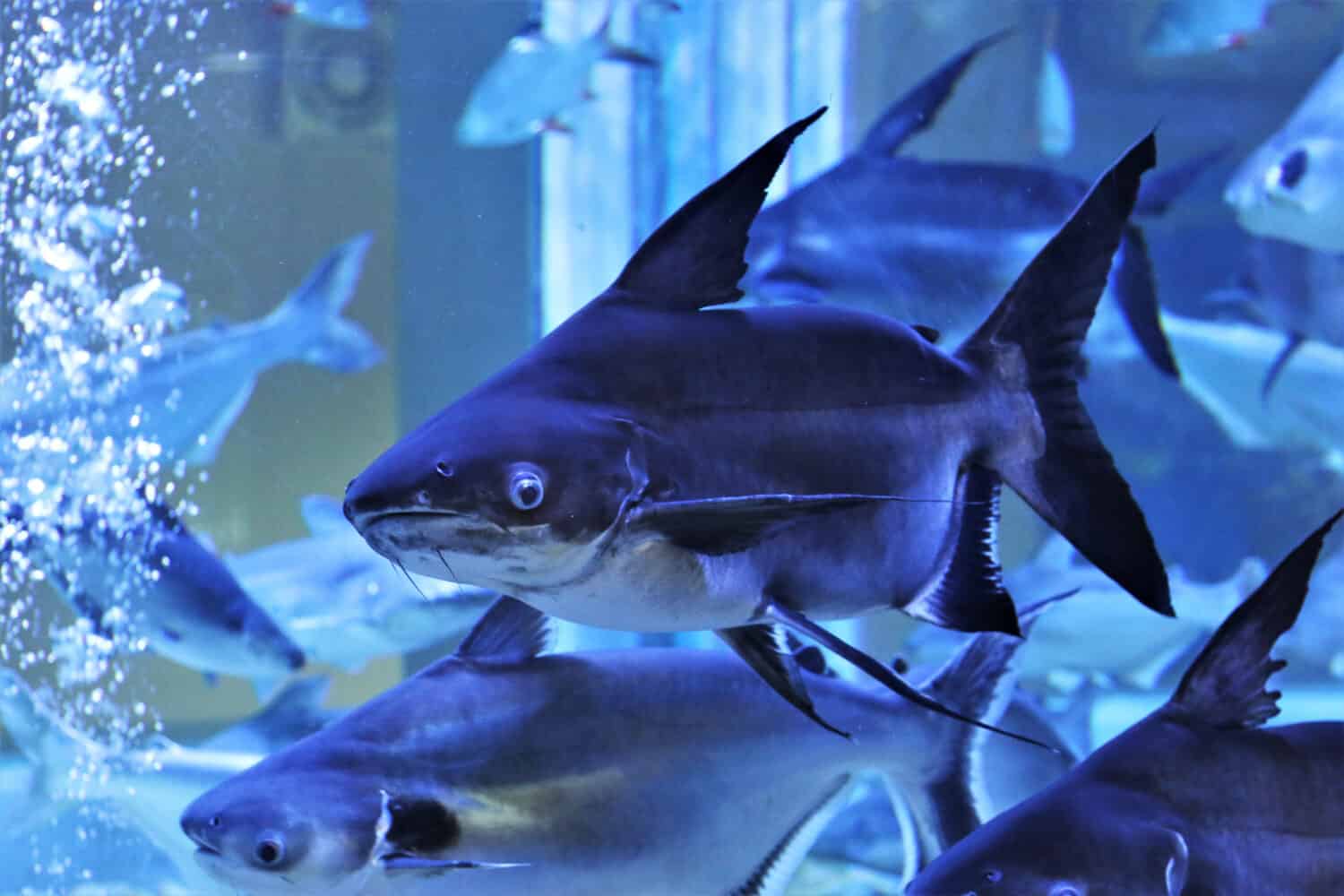
A carnivorous freshwater fish, the paroon shark has fins that resemble a shark’s.
©Arunee Rodloy/Shutterstock.com
The paroon shark is a species of freshwater fish that is part of the shark catfish family. This fish is also commonly known as giant pangasius and has long dorsal and ventral fins. The fish has a dark brown back with a silver underside, and the head of the paroon shark is wide and flat. This species of shark catfish is very large, reaching up to 10 feet in length and weighing up to 660 pounds!
The paroon shark is carnivorous and feeds on shrimp, crabs, and fish. Because paroon sharks live on the bottom of rivers, they also feed on the carcasses of large animals.
While paroon sharks are much rounder than sharks typically are, the placement of the fins resembles a shark’s.
Red-Tailed Black Shark (Epalzeorhynchos bicolor)
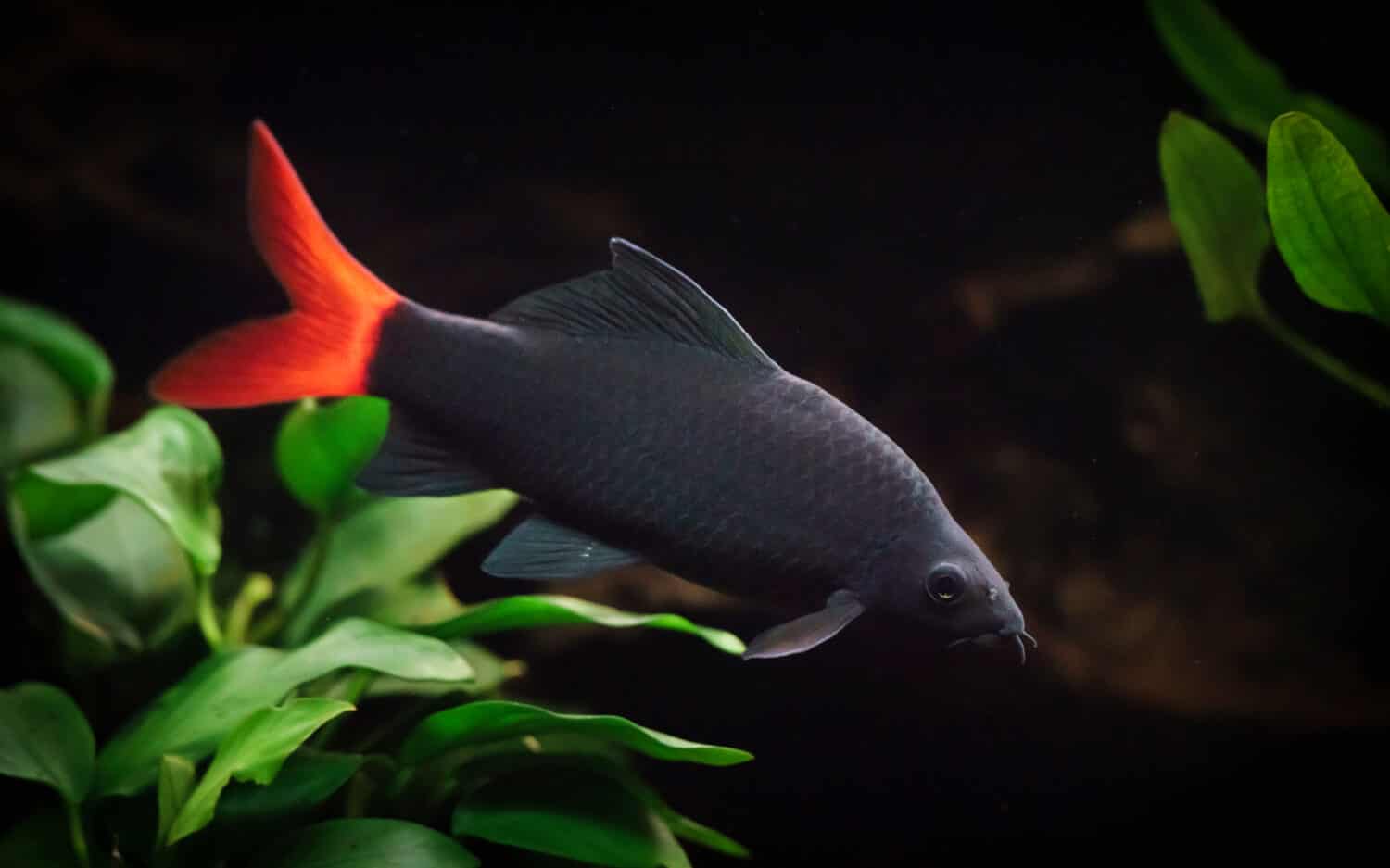
Growing only up to 6-8 inches long, red-tailed black sharks can be just as territorial and aggressive as a true shark.
©tupulointi/Shutterstock.com
Red-tailed black sharks, also known as bicolor sharks, are stunningly colored freshwater fish in the carp family Cyprinidae. These “sharks” will typically grow to 6 inches long, but it is not unusual to see some grow up to 8 inches long. They have solid black bodies with red tails, as evidenced by their name.
Red-tailed black sharks are omnivorous fish and will eat algae, plant matter, insect larvae, and small crustaceans. Aquarium-raised red-tailed black sharks can be fed bloodworms, brine shrimp, and daphnia, as well as fish flakes and pellets.
Red-tailed black sharks share many similarities to sharks, including streamlined bodies and dorsal fins paired with two pectoral fins. As well as visual similarities, their behavioral traits can also mimic those of sharks. These tiny fish can be very territorial and have aggressive tendencies.
Columbian Shark (Ariopsis seemanni)

A part of the catfish family, the Columbian shark has a high fin, just like a shark.
©Vladimir Wrangel/Shutterstock.com
The Columbian shark is not a shark but is a part of the catfish family. This fish will generally grow between 10 and 14 inches in length but can grow much larger in the right conditions. The Columbian shark has a high fin and long whiskers, which is distinctive to classic catfish. They have a dark, steel grey body with black fins. The pointed dorsal spine is connected to a venom-producing gland.
Columbian sharks are omnivores and are not picky when it comes to feeding. Typically, they will feed on crustaceans and shrimp.
The Columbian shark has a swimming pattern that closely resembles that of sharks. Their appearance is also quite similar to a shark due to their high fin, but overall, they look more like catfish than sharks, thanks to their prominent whiskers.
Remora (Echeneidae)

Remoras attach themselves to larger fish, including turtles and even sharks!
©Nicram Sabod/Shutterstock.com
Also known as sharksuckers, remoras are a fish with a powerful sucker, which they use to attach themselves to other larger fish, including sharks. By attaching themselves to these larger fish, the remora use them as protection and will often feed on any scraps left behind by the host. These fish are gray in color and can measure between 12 inches and 35 inches, depending on the species.
Remoras are opportunistic feeders and will eat anything available, including parasites from their host, scraps, smaller fish, crustaceans, and invertebrates.
This fish looks like a shark due to its long, streamlined body. Combined with the fact that they commonly attach themselves to sharks, remoras could give the impression that they are the host’s offspring.
Rainbow Shark (Epalzeorhynchos frenatum)
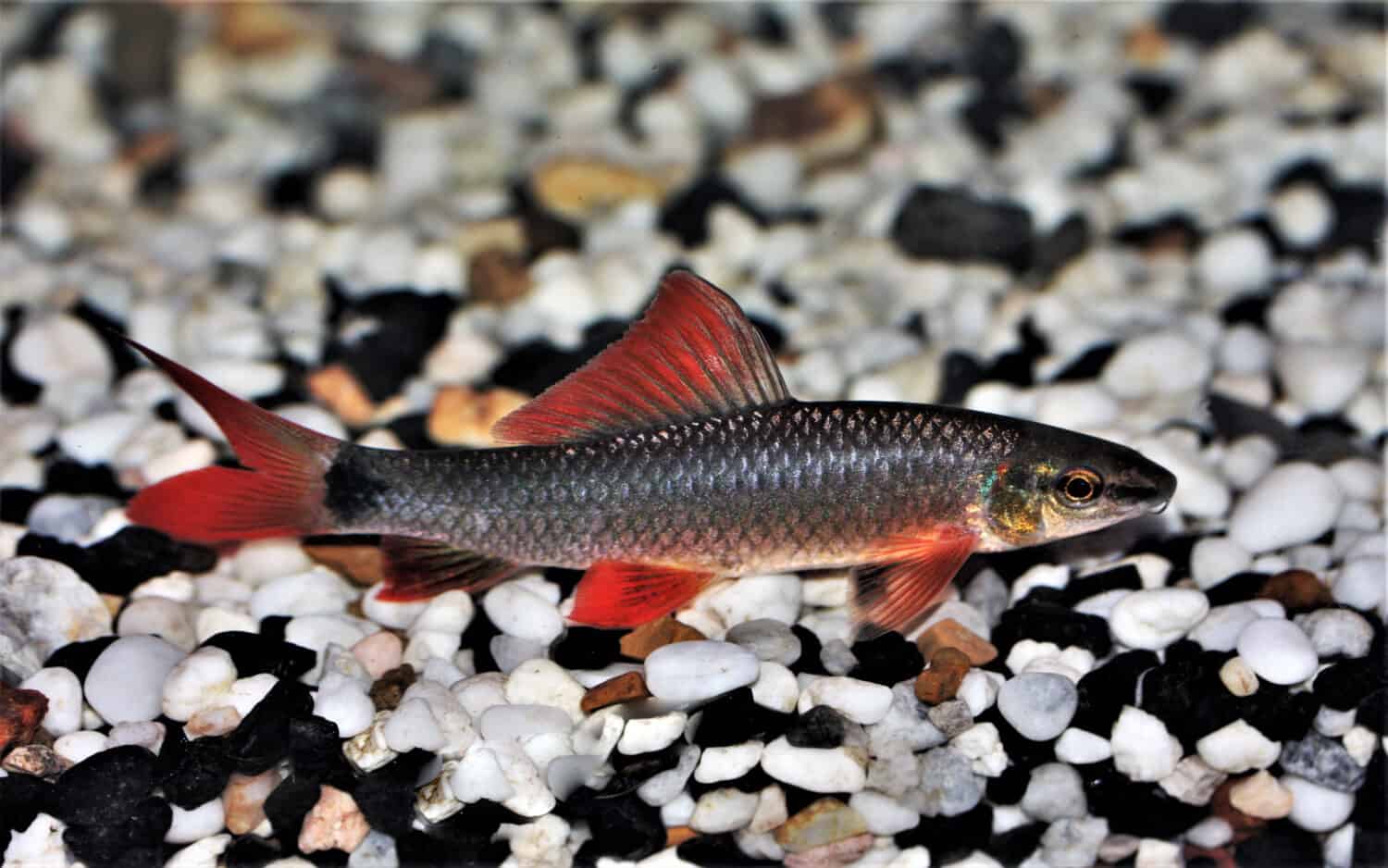
Known by a myriad of other names, the rainbow shark has a prominent dorsal fin.
©Arunee Rodloy/Shutterstock.com
The rainbow shark is a freshwater fish that is also commonly known as ruby shark, red-fin shark, rainbow sharkminnow, whitefin shark, green fringelip labeo, and white-tail sharkminnow. This species of fish is a ray-finned fish. These fish have elongated backs with a dark blue or bright blue body. They have a pointy snout and flat abdomen. The fins of the rainbow shark are red to orange-red in color. A variant of the rainbowfish includes the albino red-fin shark, which has a white body and red fins. These fish are small and grow up to just 6 inches long.
Rainbow sharks are herbivorous and omnivorous eaters. They consume algae, larvae, crustaceans, phytoplankton, zooplankton, insects, and more.
These fish look like sharks due to their prominent dorsal fin. However, the fins of the rainbow shark are feathered, unlike sharks.
Silver Apollo Shark (Luciosoma setigerum)
The silver apollo shark is a freshwater fish found in Southeast Asia. They are small to medium-sized fish that can grow up to 10 inches long. These fish are cylindrical with a pointed snout. The caudal fin is forked, and the dorsal fin is placed towards the end of the body. As the name suggests, they are silver. They have a distinguishing dark line that runs along the body. All of the fins of the silver apollo shark are silver as well.
Silver apollo sharks are predators and will eat fish that are smaller than they are. However, this species is omnivorous and is not picky.
This small fish looks like a shark thanks to its coloring. Furthermore, the dorsal fin of the silver apollo shark may look similar to a shark’s at first glance, but it is placed closer to the tail.
Roseline Torpedo Shark (Sahyadria denisonii)
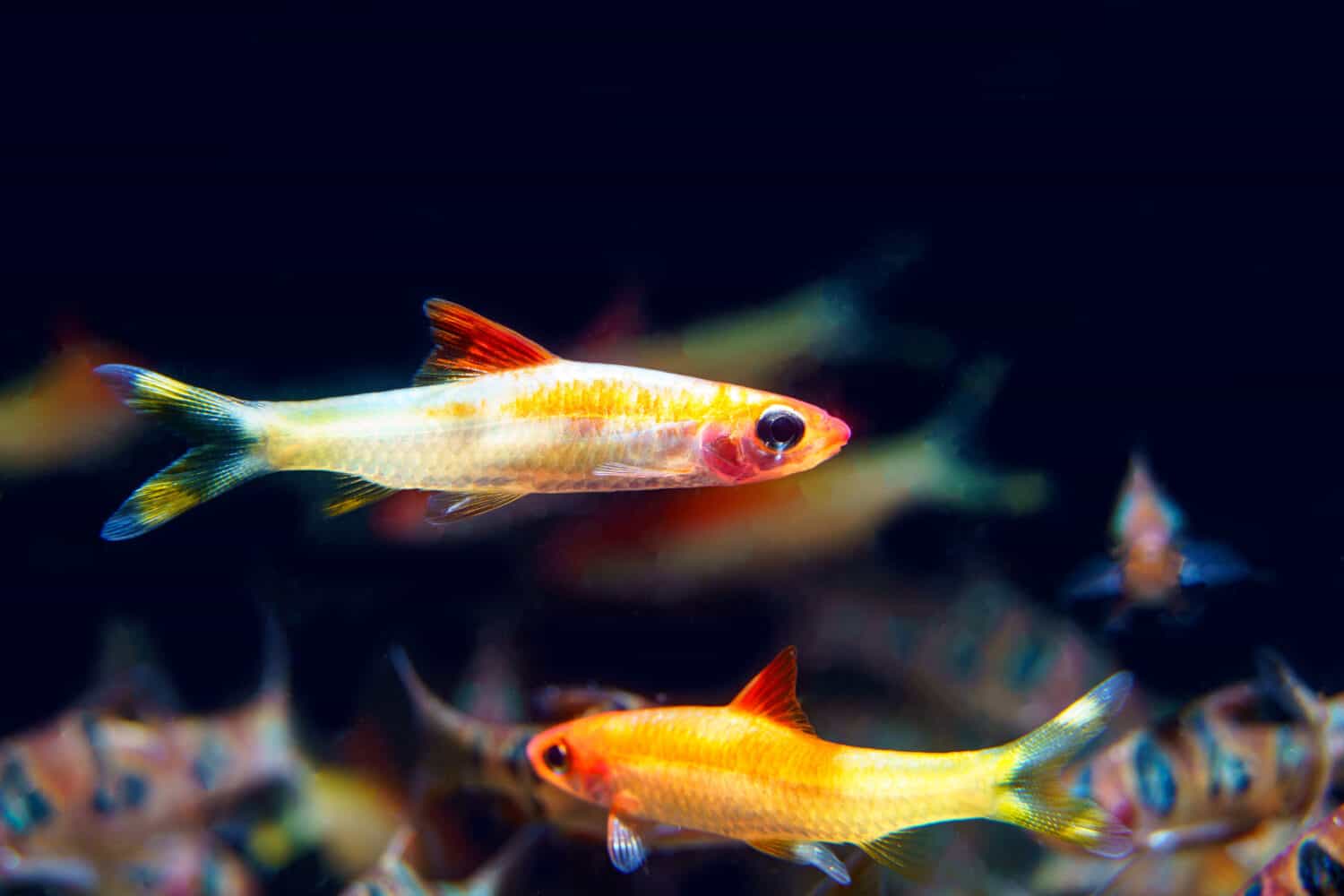
The roseline torpedo shark may not look like a shark at first glance, but they have a similar placement of their fins.
©chonlasub woravichan/Shutterstock.com
These freshwater fish, as their name implies, have sleek torpedo-like bodies and a pointed snout. They have beautiful silver-pinkish or huish-green bodies with a prominent red stripe running from their snout halfway down their bodies and a black stripe running from tip to tail.
The diet of the roseline torpedo shark includes small invertebrates, insects, small crustaceans, and algae. Tank-kept roseline torpedo sharks should be fed live or frozen foods such as bloodworms, brine shrimp, or flakes and pellets. The occasional plant matter is also required for these omnivorous fish.
These fish can look like sharks due to the placement of their fins and the size of their dorsal fins, as well as their long slender bodies.
Siamese Algae-Eater (Crossocheilus oblongus)
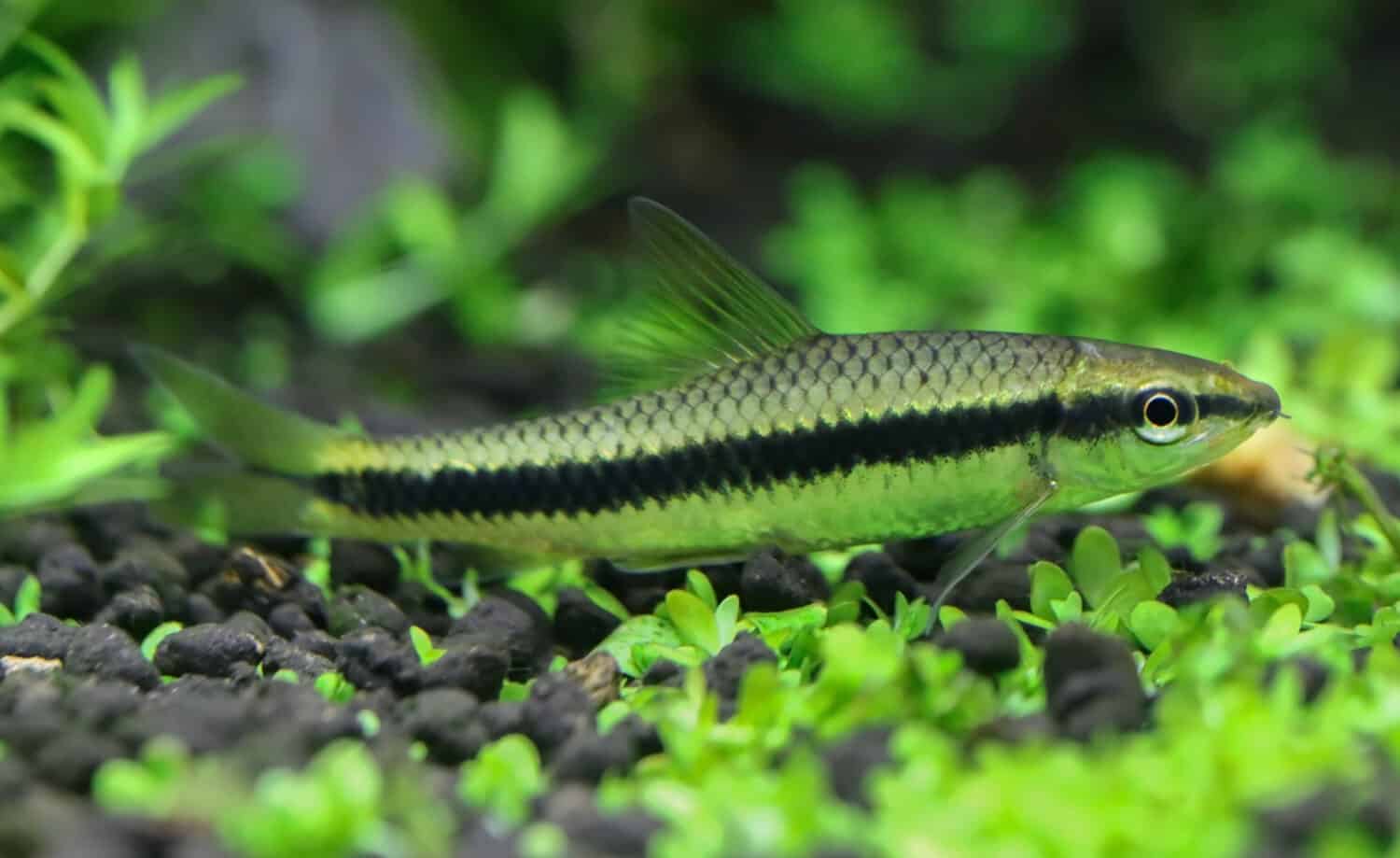
This fish’s eyes and fins resemble those of a shark.
©Swapan Photography/Shutterstock.com
The Siamese algae-eater is a freshwater fish in the carp family. This is a bottom-dwelling tropical fish that is found in Southeast Asia and can grow up to 6 inches in length. The most distinguishing feature of the Siamese algae-eater is the black horizontal stripe running from nose to tail. This fish is slender, long, and brownish-beige in color.
The Siamese algae-eater’s diet consists of algae, phytoplankton, and periphyton. This fish will also feed on dead fish and insects when they come across them.
The Siamese algae-eater resembles a shark due to the placement of its fins and eyes.
Harlequin Sharkminnow (Labeo cyclorhynchus)
The harlequin sharkminnow is a freshwater fish from central Africa. It is also commonly known as the harlequin shark and variegated shark. This fish has a distinguishing mottled coloration with a creamy-yellow base color and grey-black speckles covering the body. The harlequin sharkminnow can grow between 5.5 and 6.3 inches long and has an elongated body with stiff fins.
The harlequin sharkminnow is omnivorous and will eat almost anything. However, this species’ primary diet is aufwuchs which they graze on from the bottom.
This fish looks like a shark due to its elongated body and stiff fins, but the similarities end here.
Summary of Fish That Look Like Sharks
| Fish | Similarities | Differences |
|---|---|---|
| Bowmouth Guitarfish | Dorsal and tail fins | Wide and thick body |
| Sawfish | Dorsal fin and scales | Long, saw-like snout |
| Mekong Giant Catfish | Size, dorsal fin, the position of eyes | No teeth |
| Chinese High-Fin Banded Shark | Similar body shape | banded coloration |
| Iridescent Shark | Fins and tails | iridescent coloration |
| Black Sharkminnow | Fins | iridescent spots |
| Bala Shark | Bodies and fins | Coloration |
| Paroon Shark | Placement of fins | Round body |
| Red-Tailed Black Shark | Streamlined bodies, fins, territorial, aggressive | Bright red tail bow |
| Columbian Shark | Swimming pattern, appearance | Whiskers |
| Remora | Long, streamlined bodies | Unique sucker |
| Rainbow Shark | Dorsal fin | Very small |
| Silver Apollo Shark | Coloring | Dorsal fin |
| Roseline Torpedo Shark | Placement of fins, size of dorsal fins, long slender bodies | very bright coloration |
| Siamese Algae-Eater | Placement of fins and placement of eyes | Small, bottom-dwelling |
| Harlequin Sharkminnow | Elongated bodies, stiff fins | Small, coloring |
The photo featured at the top of this post is © Tatiana Belova/Shutterstock.com
Thank you for reading! Have some feedback for us? Contact the AZ Animals editorial team.






